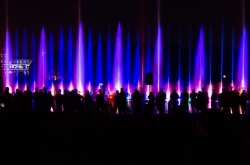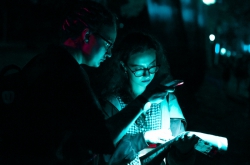For the first time round, the 2018 “Gatchina Light Nights” was a whopping two-day event instead of one. Organizers say that they want to continue increasing the festival’s duration to bring it in line with its European counterparts: for example, light festivals in the Netherlands and Finland span from five days to a whole month, attracting millions of tourists from all around the world. “Gatchina Light Nights” is also becoming more and more international: this year, festival coordinators worked with dozens of applications coming from seven countries: Brazil, Portugal, Italy, Russia, Belarus, Germany, and Finland. Only 24 artworks were shortlisted, though. Its authors displayed their creative takes on this year’s theme, “Paradoxes”.
“It’s important for a theme to favor artistic expression. When I was choosing this year’s theme, I was thinking about what would inspire the artists and push them to think outside of the box. Encountering something paradoxical makes us realize that real life isn’t what we thought it was, so paradoxes challenge our understanding of things. The festival projects turned out to be very diverse: some participants worked with well-known paradoxes like the Schrödinger’s cat or the chicken and egg question, while others chose to reflect on something more abstract. Every artist’s approach was original and different from the rest. That’s because the subject of paradoxes, like the last year’s theme of dreams, offers boundless opportunities to create,” explains the festival’s organizer Olga Arshanskaia.

After one year worth of preparation, Russian and international artists came up with more than three and a half dozens of installations. It would take several hours for a spectator to see them all. Among the festival showstoppers was a laboratory of no less than Doctor Faustus himself. Designed by the Russian Engineering Theater visionaries Vadim Gololobov, Nick Khamov, and Yury Galkin, this project featured kinetic objects, each functioning on its own idiosyncratic laws, and it was the audience’s role to establish them. In addition to that, Nick Khamov and Yury Galkin decided to up their game by creating a performance installation called “Faustus 3.2 LABOR”, while Vadim Gololobov joined the forces with an artist Alena Kogan and optical geometry and mirror paradoxes engineer Sergey Karlov to devise a series of dynamic light installations dubbed “The Removal of Cultural Layers”. Last year, Alena Kogan’s and Vadim Gololobov’s joint installation performance creation became a clear audiences’ favorite.
The installation made by Kazan artists focused on the quantum-mechanical Schrödinger's cat paradox. This is a thought experiment devised by Austrian physicist Erwin Schrödinger in 1935. Looking at the installation, you can imagine yourself being a quantum cat locked in a chamber, alive and dead at the same time.

“This kind of art we have here is very progressive, but at the same time, it’s popular, not elitist. The “Gatchina Light Nights” festival is not only for lighting design connoisseurs but also for the wider public. What makes this festival truly special is its emotional component, as many people would never go to an art gallery, and this festival offers them a great opportunity to familiarize themselves with contemporary art,” comments Olga Arshanskaia.
Among other projects presented in Gatchina was the Lantern Park launched in collaboration with the LUX Helsinki festival. Students, school children, pensioners, volunteers, and journalists took part in a series of workshops by Mia Kivinen from Helsinki and made 100 unique lanterns that then were used to decorate the Love Island, the most romantic place in the park. But the cherry on the cake was “Near the Horizon”, a unique multimedia show with fire, water, surrealistic pictures, live music, and fireworks.

“The Gatchina Park is very beautiful, but at the same time, it has a difficult landscape to design on. When working with something like that, you have to take a special approach to every location: every tree and every meadow is important. That’s why we always work in close collaboration with museum professionals, as well as parks’ conservationists and activists. When organizing such events, it might be hard to avoid arguments between the event’s coordinators and conservationists, as the former want to attract as many people to the event as possible, while the latter want to preserve the place. It is important to find a compromise,” said Olga Arshanskaia.
At midnight, Gatchina’s White Lake was illuminated by thousands of lights created by pyrotechnic explosions. Audiences could enjoy this mesmerizing show from several viewpoints. Also watching the fireworks was the competition jury board consisting of celebrated artists and creators (Gleb Filshtinsky, Evgeny Ginzburg, Vadim Gololobov), leading lighting design specialists (Natalia Bystryanzeva, Vasiliy Tarasenko, Ulyana Vinogradova), as well as cultural organizations representatives from Russia and all over the world. International lighting designers’ community was represented by the LUX Helsinki light festival artistic director and curator Ikka Paloniemi.

The experts have already chosen the competition winner, who will be awarded a 100,000 RUB prize at a special ceremony which will take place on an Alexandrinsky theater’s New Stage in September.




